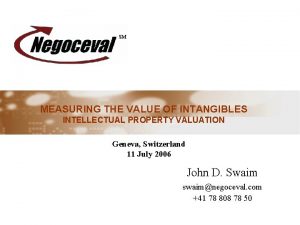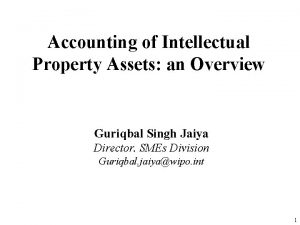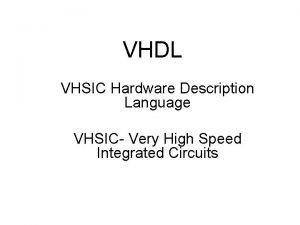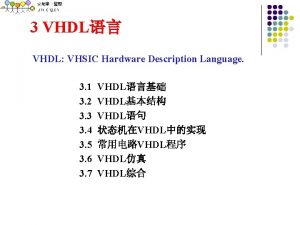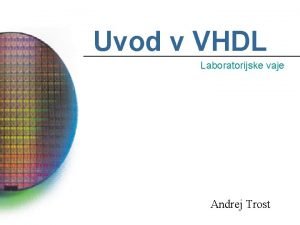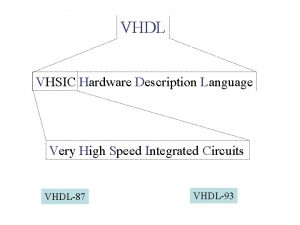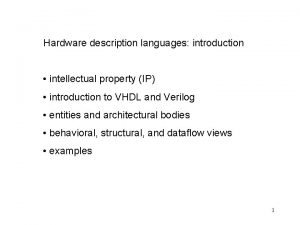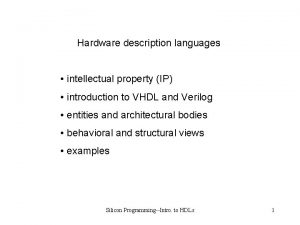Hardware description languages introduction intellectual property IP introduction

































- Slides: 33

Hardware description languages: introduction • intellectual property (IP) • introduction to VHDL and Verilog • entities and architectural bodies • behavioral and structural views • examples Silicon Programming--Intro. to HDLs 1

Silicon Programming--Intro. to HDLs 2

Silicon Programming--Intro. to HDLs 3

Silicon Programming--Intro. to HDLs 4

Two main HDLs: VHDL / Verilog • VHDL--Very High Speed Integrated Circuit (VHSIC) Hardware Description Language Standards--IEEE 1076 -1987; 1076 -1993; Ada-like language Additions--VHDL-AMS--Analog & Mixed Signal • Verilog— 1985; proprietary to Cadence until 1990 (“open Verilog”) C-like language Additions—Verilog-AMS—Analog & Mixed Signal NOTE: this course is NOT designed to make you a VHDL or Verilog expert! The Altera tools (as well as other synthesis tools) work best with simpler HDL constructs (e. g. , structural representations, modeest levels of nesting) Silicon Programming--Intro. to HDLs 5

Silicon Programming--Intro. to HDLs 6

Silicon Programming--Intro. to HDLs 7

Silicon Programming--Intro. to HDLs 8

Silicon Programming--Intro. to HDLs 9

Note: keywords, comment, “entity” syntax Silicon Programming--Intro. to HDLs 10

Silicon Programming--Intro. to HDLs 11

? ? ? Silicon Programming--Intro. to HDLs 12

? ? ? Silicon Programming--Intro. to HDLs 13

Full adder example: Silicon Programming--Intro. to HDLs 14

Silicon Programming--Intro. to HDLs 15

Silicon Programming--Intro. to HDLs 16

Silicon Programming--Intro. to HDLs 17

Silicon Programming--Intro. to HDLs 18

Silicon Programming--Intro. to HDLs 19

Silicon Programming--Intro. to HDLs 20

Silicon Programming--Intro. to HDLs 21

Silicon Programming--Intro. to HDLs 22

Silicon Programming--Intro. to HDLs 23

Silicon Programming--Intro. to HDLs 24

Verilog: The following is taken from the introduction by Dan Hyde at: http: //www. eg. bucknell. edu/~cs 320/1995 -fall/verilog-manual. html Other references can be found at: http: //www. verilog. net/docs. html Architectural, behavioral, gate, and switch levels supported Gate level: logic elements (structural) Switch level: transistor level Verilog program can be used for design, simulation, synthesis Basic construct: module Verilog program consists of interconnected modules Usually a “top” module encapsulates all the others Silicon Programming--Intro. to HDLs 25

Some simple examples of combinational logic: // NAND gate (behavioral model) module NAND(in 1, in 2, out); input in 1, in 2; output out; assign out = ~(in 1 & in 2); endmodule //AND gate (structural module) module AND(in 1, in 2, out); input in 1, in 2; output out; wire w 1; NAND 1(in 1, in 2, w 1); NAND 2(w 1, out); endmodule Silicon Programming--Intro. to HDLs 26

A simple sequential logic example—what does it do? (Note “control statements” initial and always—these will run concurrently) module simple; reg [0: 7] A, B; reg C; //stop execution after 20 time steps initial begin: stop_at // Will stop the execution after 20 simulation units. #20; $stop; end //so these statements at time 0 A = 0; $monitor(" %0 d %b %b %b", $time, A, B, C); end //main_process will loop until simulation is over (#1 means do at each step) always begin: main_process #1 A = A + 1; #1 B[0: 3] = ~A[4: 7]; #1 C = &A[6: 7]; endmodule Silicon Programming--Intro. to HDLs 27

Assignment: • Default is that new assignment is made whenever inputs change: assign out = ~( in 1 & in 2) • Blocking and nonblocking statements: Blocking: =; works like a “regular” programming language; Nonblocking: <=; does all right-hand assignment simultaneously module blocking; reg [0: 7] A, B; initial begin: init 1 A = 3; #1 A = A + 1; B = A + 1; $display("Blocking: A= %b B= %b", A, B ); A = 3; #1 A <= A + 1; B <= A + 1; #1 $display("Non-blocking: A= %b B= %b", A, B ); endmodule output: Blocking: A= 00000100 B= 00000101 Non-blocking: A= 00000100 B= 00000100 Silicon Programming--Intro. to HDLs 28

Tasks and functions Verilog has tasks, which are like procedures (do not return a value) Verilog also has functions, which must execute and return a value in 1 time step A task can invoke a function; a function cannot invoke a task Example: module tasks; task add; input a, b; output c; reg R; begin R = 1; if (a == b) c = 1 & R; else c = 0; endtask initial begin: init 1 reg p; add(1, 0, p); //invoke the task $display("p= %b", p); endmodule (A similar function can also be defined) Silicon Programming--Intro. to HDLs 29

Timing: Like VHDL, Verilog uses discrete event simulation The following can advance timing (order of events may not be predictable): 1. gate or wire delay, if specified. 2. a delay control, introduced by the # symbol. 3. an event control, introduced by the @ symbol. 4. the wait statement. Silicon Programming--Intro. to HDLs 30

Examples: Delay control: #10: A = A + 1; //delay 10 units before executing the assignment Event control: @r begin // controlled by any value change in reg r A = B&C; end @(posedge clock 2) A = B&C; // controlled by positive edge of clock 2 @(negedge clock 3) A = B&C; // controlled by negative edge of clock 3 forever @(negedge clock) begin A = B&C; end Silicon Programming--Intro. to HDLs 31

Control by a specific event: @(event 6) begin <some procedural code> end To trigger the event: -> event 6 Wait statement: wait until condition becomes true (level sensitive): wait (A == 3) begin A = B&C; end Silicon Programming--Intro. to HDLs 32

Fork / join: allow multiple threads Example: fork: three begin // code for thread 1 end begin // code for thread 2 end begin // code for thread 3 end join All 3 threads execute concurrently; when all are finished, jump to statement after “join” Silicon Programming--Intro. to HDLs 33
 Hardware description language
Hardware description language Trade-related aspects of intellectual property rights
Trade-related aspects of intellectual property rights Secondary infringement
Secondary infringement Importance of intellectual property
Importance of intellectual property Intellectual property management definition
Intellectual property management definition Advantages of intellectual property
Advantages of intellectual property Intellectual property business plan example
Intellectual property business plan example Intellectual property in computer ethics
Intellectual property in computer ethics Right to intellectual property of teachers
Right to intellectual property of teachers Intellectual property definition
Intellectual property definition Incentive theory
Incentive theory Concept of intellectual property
Concept of intellectual property Valuation of ip
Valuation of ip Intellectual property rights
Intellectual property rights Intellectual property rights
Intellectual property rights Characteristics of intellectual property
Characteristics of intellectual property Discuss intellectual property frankly
Discuss intellectual property frankly Gaap accounting for intellectual property
Gaap accounting for intellectual property Intellectual property
Intellectual property Intellectual property statement
Intellectual property statement Intellectual property business plan example
Intellectual property business plan example Evalueserve ip
Evalueserve ip Discuss intellectual property frankly
Discuss intellectual property frankly At&t ecommerce
At&t ecommerce Computer external components
Computer external components Vhsic hardware description language
Vhsic hardware description language Hdl language
Hdl language Vhsic hardware description language
Vhsic hardware description language Hardware description language
Hardware description language The verilog® hardware description language
The verilog® hardware description language Vhsic hardware description language
Vhsic hardware description language Commutative property vs associative property
Commutative property vs associative property Obstructed heritage and unobstructed heritage
Obstructed heritage and unobstructed heritage Physical property and chemical property
Physical property and chemical property












